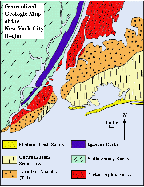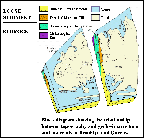| Click on the thumbnail image of Figure 7. |  |
In most areas of Manhattan and the Bronx, bedrock is at or close to the surface of the earth. In Brooklyn and Queens, bedrock is buried by significant thicknesses of sediment. The depth of the bedrock in these boroughs may be seen in Figure 7.
Click on the thumbnail image
of Figure 7. 
Because bedrock is not exposed at the surface, hypotheses other than differential erosion of bedrock must be sought to explain the landscape. Three major landscape features occur:
These features may also be seen in Figure 7 (above) and also in Figures 2 and 4.
Thumbnail of Figure 2. 
Thumbnail of Figure 4. 
Figure 8 is block diagram that shows the topography and geology of western Long Island (including Brooklyn and Queens) in three dimensions.
Thumbnail of Figure 8. 
1. Print this web page.
2. Describe the sediment samples and note their locations in Figures 2 and 7. In your description, pay special attention to the features that distinguish each type of sediment from the others:
| Specimen Location & Number | Layering | Color | Uniformity of Grain Size | Minerals or Shell Fragments Present |
| Hills #_____ | ||||
| Plain #_____ | ||||
| Beach #_____ | ||||
| Dune #_____ |
3. Explain the differences between the beach and dune sediment in terms of their origin.
4. Sample 12 is a piece broken from a very large boulder (ten feet in diameter) found mixed in with the sediment out of which the hills are made. Boulders made of the same rock type as sample 12 are also found in Manhattan and the Bronx, resting on bedrock. (SEE PICTURES OF BOULDERS) In those boroughs, some (but not all) of the boulders are found at the very tops of hills. What is the name of the rock out of which the boulders are made?
5. Boulders made out of the rock types composing samples 4, 5, 6, and 7 are also found in the hill sediments. (SEE PICTURES OF HILL SEDIMENT) Where, with respect to the Hudson River, is bedrock of the same compositions as samples 4, 5, 6, and 7 found? (Consult Figure 5.)
6. The location of bedrock similar in composition to these samples is ____________________the Hudson River.
7. DEVELOPING HYPOTHESES AS TO THE ORIGIN OF THE BOULDERS: Let us assume that the boulders in the hill sediment represent pieces of rock torn off from the bedrock and transported to their present sites in the northern hills of Brooklyn and Queens. Suggest two geologic agents that might be capable of tearing off and moving boulders of this size.
(SEE PICTURE SET I) (SEE PICTURE SET II) (SEE PICTURE SET III) (SEE PICTURE SET IV) (SEE PICTURE SET V) (SEE PICTURE SET VI)
8. Is geologic agent A at work in this region today? ____________ Is agent B?____________
9. If the geologic agent is not at work in this region today, where might it be seen in action?
Agent A:_________________ Agent B:_________________
10. If we could see the agent in action, we might be able to see what else it does to the landscape aside from transporting large boulders. That is, aside from the transport of large boulders, this geologic agent may create other evidence that we might be still able to see today in the New York City region. Give examples of such evidence. (If you have neither the time nor the money to fly to where the geologic agent is now at work, you might go to the library and look in a geology textbook for some answers.)
Evidence for agent A:
Evidence for agent B:
11. In terms of each of your hypotheses as to the agent that transported the boulders, explain the following:
12. Which of your two hypotheses as to the agent of transport of the boulders is more likely correct? EXPLAIN WHY.
13. What are the characteristics of a useful hypothesis?
14. What makes a hypothesis valid ('correct')?
© 2000
David J. Leveson